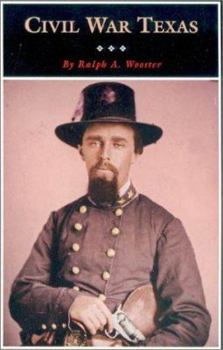Civil War Texas
(Part of the Fred Rider Cotten Popular History Series Series)
Written by one of the deans of Texas history, Civil War Texas provides an authoritative, comprehensive description of Texas during the Civil War as well as a guide for those who wish to visit sites in Texas associated with the war. In one compact volume, the reader or tourist is led on an exciting historical journey through Civil War Texas. Because most of the great battles of the Civil War were fought east of the Mississippi River, it is often forgotten that Texas made major contributions to the war effort in terms of men and supplies. Over 70,000 Texans served in the Confederate army during the war and fought in almost every major battle. Ordnance works, shops, and depots were established for the manufacture and repair of weapons of war, and Texas cotton shipped through Mexico was exchanged for weapons and ammunition. The state itself was the target of the Union army and navy. Galveston, the principal seaport, was occupied by Federal forces for three months and blockaded by the Union navy for four years. Brownsville, Port Lavaca, and Indianola were captured, and Sabine Pass, Corpus Christi, and Laredo were all under enemy attack. A major Federal attempt to invade East Texas by way of Louisiana was stopped only a few miles from the Texas border. The Civil War had significant impact upon life within the state. The naval blockade created shortages requiring Texans to find substitutes for various commodities such as coffee, salt, ink, pins, and needles. The war affected Texas women, many of whom were now required to operate farms and plantations in the absence of their soldier husbands. As the author points out in the narrative, not all Texans supported the Confederacy. Many Texans, especially in the Hill Country and North Texas, opposed secession and attempted either to remain neutral or work for a Union victory. Over two thousand Texans, led by future governor Edmund J. Davis, joined the Union army. In this carefully researched work, Ralph A. Wooster describes Texas's role in the war. He also notes the location of historical markers, statues, monuments, battle sites, buildings, and museums in Texas which may be visited by those interested in learning more about the war. Photographs, maps, chronology, end notes, and bibliography provide additional information on Civil War Texas.
Format:Paperback
Language:English
ISBN:0876111711
ISBN13:9780876111710
Release Date:June 1999
Publisher:Texas State Historical Assn
Length:88 Pages
Weight:0.50 lbs.
Dimensions:0.3" x 4.8" x 8.6"
Customer Reviews
1 rating
Nice synopsis
Published by Thriftbooks.com User , 17 years ago
This book is not overly ambitious but is nevertheless a good overview of a very hard period of Texas history. It should be used primarily as a synopsis leading to more detailed study of important events. Even though the book is almost an outline, I still learned things I hadn't heard before. I didn't realize, for example, that most Texas men of military men joined the Confederate military. I don't doubt the accuracy of this but believe, from a patriotism perspective, that this is remarkable. I can't think of any other war in U.S. history where men would have joined in these kinds of percentages. Granted, the Confederacy ultimately resorted to the draft but apparently most of these people were volunteers. I think that this must have been one of the reasons for the lethality of the Civil War. No doubt Northerners in some states joined with similar fervor. The result was huge armies composed of highly motivated men meeting on the field of battle--620,000 deaths--more than all other wars in U.S. history combined. Modern propagandists promote the idea that this blood bath "unified" the nation. I wonder. Ron Braithwaite, author of novels--"Skull Rack" and "Hummingbird God"--on the Spanish Conquest of Mexico






